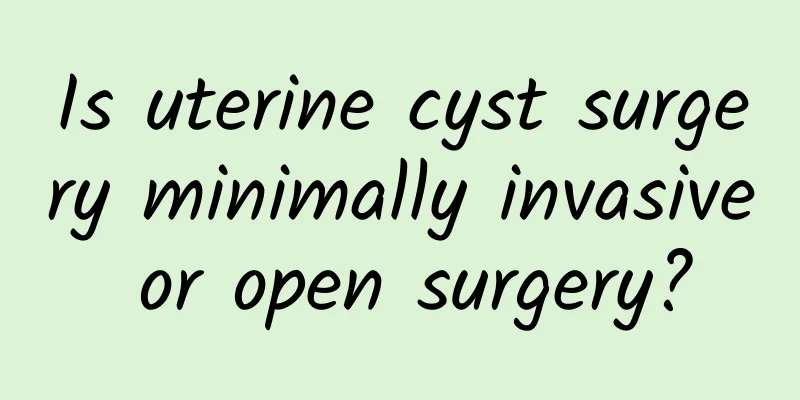Experts specifically introduce the symptoms of ovarian cysts

|
It is good for women to understand the symptoms of ovarian cysts in their daily lives, which is conducive to self-observation. Now, let the experts discuss with you what the symptoms of ovarian cysts are. I hope it can help you better understand the symptoms of ovarian cysts . 1. The symptoms of ovarian cysts are not obvious in the early stage. Patients with ovarian cysts are often found during gynecological examinations when they seek medical treatment for other diseases. Later, as the tumor grows, the patient will feel it. The symptoms and signs vary depending on the nature, size, development, and presence or absence of secondary degeneration or complications of the tumor. 2. Symptoms of ovarian cysts include lower abdominal discomfort, which is the initial symptom before the patient feels a lump in the lower abdomen. Due to the weight of the tumor itself and the influence of intestinal peristalsis and body position changes, the tumor moves in the pelvic cavity, pulling on its pedicle and pelvic funnel ligament, causing the patient to feel distension and falling in the lower abdomen or iliac fossa. 3. Increased abdominal circumference and abdominal mass These are the symptoms of ovarian cysts: they are the most common phenomena in the main complaint. The patient finds that his clothes or belts are too tight, and then notices that his abdomen is enlarged, or feels it accidentally in the morning, so he presses his abdomen and finds that there is a mass in the abdomen, plus abdominal distension and discomfort. 4. Abdominal pain is one of the symptoms of ovarian cysts. If the tumor has no complications, there is little pain. Therefore, if patients with ovarian tumors feel abdominal pain, especially if it occurs suddenly, it is mostly caused by the torsion of the tumor pedicle, or occasionally by tumor rupture, bleeding or infection. In addition, malignant cysts often cause abdominal pain and leg pain, and the pain often causes patients to seek emergency treatment. 5. Menstrual disorders are also symptoms of ovarian cysts. Some uterine bleeding is not endocrine, or it is caused by ovarian tumors that change the distribution of pelvic blood vessels, causing endometrial congestion; or it is caused by ovarian malignant tumors directly metastasizing to the endometrium. Menstrual disorders caused by endocrine tumors are often combined with other secretory effects. Through the above introduction, everyone should have some understanding of the symptoms of ovarian cysts. I hope it can bring some help to everyone. I wish patients can choose the treatment method that suits them as soon as possible and recover soon. |
<<: Experts introduce two causes of ovarian cysts as follows
>>: Experts propose a method for diagnosing ovarian cysts
Recommend
What are the auxiliary examination methods for the diagnosis of uterine fibroids?
Women must be very interested in the diagnosis of...
What are the causes of cervical erosion?
In today's society, many female friends suffe...
Is it good to drink brown sugar water during menstruation? It is very beneficial
Drinking some brown sugar water during menstruati...
Breast examination for perimenopausal women
What are the breast examinations for perimenopaus...
What causes recurrent miscarriage? Let's take a look.
There are many reasons for recurrent miscarriage ...
How to prevent cervical warts from spreading to others
Now cervical warts have seriously threatened all ...
When is the best time to have an abortion? What is the best time to have an abortion with medicine?
With the development of today's society, peop...
Armpit fat is such a problem! 2 movements to detoxify and slim your arms
Armpit fat is not exclusive to older people. Many...
Can I take anti-inflammatory drugs for cervical inflammation?
Cervical inflammation can be treated with anti-in...
Experts introduce the causes and symptoms of fallopian tube pregnancy
Everyone has heard of tubal pregnancy. How much d...
The difference between self-testing fungal and bacterial vaginosis
The difference between self-diagnosed candidal va...
Is there any shadow? Will eating enoki mushrooms cause cancer? If the body becomes acidic, will cancer come knocking on your door?
Enoki mushrooms are a must-have ingredient on the...
Symptoms of vulvar leukoplakia
When it comes to vulvar leukoplakia, many women m...
What causes uterine fibroids? What is the relationship between uterine fibroids and estrogen?
During pregnancy, the woman should be closely mon...
Left Bartholin's gland cyst
The Bartholin's gland cyst on the left is usu...









